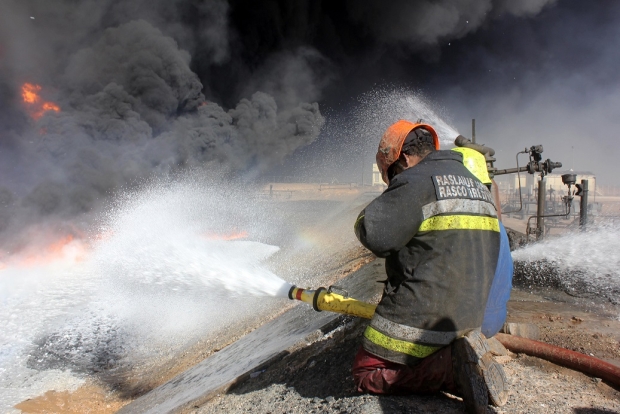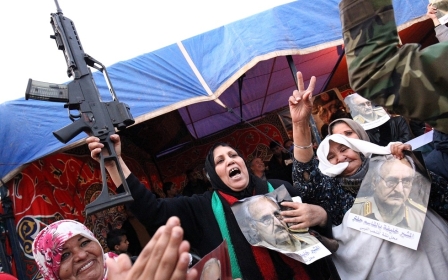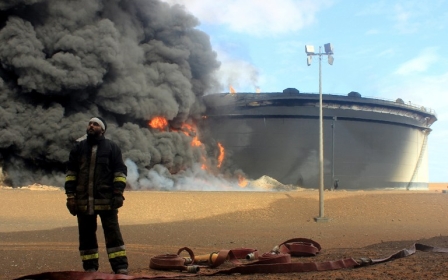How Emirati air power turned Haftar's Libyan oil ports disaster to victory

On 14 March, General Khalifa Haftar's Libyan National Army launched a counterattack against the fighters of the Saraya Defend Benghazi and the Petroleum Facilities Guard coalition, which had managed to take most of the coastal cities near the oil terminals 10 days earlier.
How could an army have lost an entire region in a few days - and then recovered it so quickly?
This lightning counter-offensive has left observers skeptical. How could an army have lost an entire region in a few days - and then recovered it so quickly?
The reasons for the failure of Haftar to contain the offensive on the oil terminals in the first place were multiple. Unlike their first attempt in December 2016, the SDB and PFG fighters managed to rally some militias from Misrata including the al-Marsa Brigade. That's the first reason.
Secondly, the SDB-PFG convoy coming from Zillah, a town in the Sahara Desert where the SDB were based, joined the fight quickly and attacked several locations, taking Haftar troops - which were already limited in number because they were fighting on other fronts, particularly Derna - by surprise. The UAE's Wing Loong drones, supporting Haftar's forces, apparently failed to spot the oncoming convoy in the desert.
Another major reason for the failure of the LNA is the lack of air support as a result of a significant attrition in Libya's air force, mostly equipped with 30-year-old aircraft, since December. One MiG-23 was shot down over the Ganfouda-Bosnib area in Benghazi on 15 January and two Mi-35 Russian attack helicopters were lost, one of them abandoned at Ras Lanouf.
The Haftar-led air force had only five MiG-21 and MiG-23 operational fighter jets and some Mi-8 and Mi-35 helicopters to battle the SDB and PFG fighters. A MiG-23 was being renovated and the aircrafts delivered by Russia at the end of February had not yet been reassembled entirely. It would also appear that the Emirati aircraft based at Al-Khadim air field in al-Marj did not intervene.
Air support played a decisive role with many strikes - some very accurate - carried out during the night of 13-14 March
Ten days later, after several counter-attacks, the LNA retook the cities one by one as well as the airport at Ras Lanouf. Air support played a decisive role with many strikes - some very accurate - carried out during the night of 13-14 March.
But how did an air force, reduced to five old MiGs and a few helicopters, manage this feat only 10 days after losing the territory? How could a fleet of old-as-hell aircraft have been able to hold such a pace without requiring heavy maintenance which would have taken warplanes out of operation?
The most plausible hypothesis is that the LNA has benefited from the aid of the United Arab Emirates or Egypt - or both.
Egypt's air strikes in Libya
From the outset of Haftar's Operation Dignity in May 2014 and Operation Libya Dawn, a counter-offensive launched in July 2014 by a coalition of Islamist and regional militias, Egypt has supported the Tobruk government and Haftar.
On 17 August 2014, two unidentified aircraft bombed the camp of Wadi Rabie and an ammunition store belonging to "Misrata's Hattin Brigade", a militia fighting at the time to control the Libyan capital, near the Tripoli International Airport.
One week later, the New York Times reported that four senior American officials had confirmed that Egypt and the UAE had secretly launched two air strikes against Islamist-allied militias that were fighting for the control of Tripoli. The two countries denied their forces had taken direct action in Libya.
On 16 February 2015, six Egypt Air Force (EAF) F-16s carried out air strikes against training centres and ammunition stores of the Islamic State (IS) group in Derna, in retaliation for the killing of 21 Egyptian Coptic Christians migrant workers kidnapped in the city of Sirte in December 2014 and January 2015.
Nearly a year later, on 7 February 2016, unidentified aircrafts attacked Derna's Bab Tobruk district and an area controlled by the Shura Council of Mujahideen in Derna (SCMD), killing four civilians and two fighters. According to Libyan sources, the air strikes hit an SCMD arms and ammunition store in a residential area which caused huge explosions.
Colonel Hamza Muftah of the LNA denied that his troops or the air force had been involved. Egyptian and UAE air forces were therefore suspected.
Then on 28 February, a convoy of 15 vehicles was attacked by an unidentified aircraft in the Shimikh Valley near Bani Walid. The US and the LNA denied any involvement in the attacks and, again, the Egyptian and UAE were suspected of being involved.
The Emirati air base supporting Haftar
Sometime between May and June 2016, the UAE deployed six Air Tractors and three Wing Loong drones at Al-Khadim air field. On 4 June, the Shura Council of Benghazi Revolutionaries (SCBR) - a group with ties to al-Qaeda - released photos of what they claim to be a "US-made bomb used by Emirati aircraft" in Benghazi.
In fact this guided bomb was a Mk-82 made in Turkey (built by the Turkish company Ucak Bombasi MKE) with a Paveway kit, and may have been the first evidence of the engagement of the "Air Tractor" in Libya. Air Tractors are light attack turboprop aircraft which can perform reconnaissance missions and can also carry guided bombs and Gatling guns.
Since the start of this year, Emirati turboprop planes have reportedly been piloted by mercenaries working for former Blackwater boss Erik Prince
In September, the SCBR media published an infographic on types of aircraft alleged to be involved in air strikes in Benghazi over the past three months. According to this group, the AT-802 Air Tractors were involved in 27 bombing missions. Twice in November, the SCBR published photos of a UAE Air Force AT-802 and Wing Loong drones in the sky of Ganfouda area of Benghazi.
And on 4 November, the SCBR media published a new infographic of October air strikes. According to the infographic, the AT-802s and the Wing Loongs respectively flew 13 and 41 bombing missions - or 85 percent of all air raids over Benghazi that month. By mid-November, 44 air strikes were conducted in Ganfouda, 23 of which were Emirati, according to SCBR.
Since the start of this year, Emirati turboprop planes have reportedly been piloted by mercenaries working for Erik Prince, founder and former CEO of the private military company Blackwater.
In December 2016, al-Khadim air base expanded significantly with the construction of a second parking area twice as large as the existing one, able to accommodate fighter jets such as the Mirage 2000 and F-16. The UAE has already carried out such installations and deployments at Assab airport in Eritrea where 12 shelters, five Mirage 2000-9s and at least three Wing Loongs were spotted in November.
With such a deployment, the SDB-PFG coalition can forget any major offensive to retake the oil crescent. Their early March attack was probably their last chance to take the area. At the rate of losses suffered by Haftar - including a new MiG-21 shot down on 18 March - and the few "old" aircraft delivered to date by Russia, Haftar is now dependent on the Egyptian and UAE air forces to carry out his air operations.
- Arnaud Delalande is a French analyst, author and journalist specialised in military aviation.
The views expressed in this article belong to the author and do not necessarily reflect the editorial policy of Middle East Eye.
Photo: Libya's oil terminal at Ras Lanouf. The oil ports were retaken by forces of the Libyan National Army in recent days after a lightning strike by SDB and PFG fighters (AFP)
Middle East Eye propose une couverture et une analyse indépendantes et incomparables du Moyen-Orient, de l’Afrique du Nord et d’autres régions du monde. Pour en savoir plus sur la reprise de ce contenu et les frais qui s’appliquent, veuillez remplir ce formulaire [en anglais]. Pour en savoir plus sur MEE, cliquez ici [en anglais].






